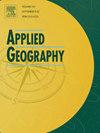Exploration of ecological compensation standard: Based on ecosystem service flow path
IF 5.4
2区 地球科学
Q1 GEOGRAPHY
引用次数: 0
Abstract
Ecosystem service flows are crucial links connecting ecosystems and human well-being. Clarifying the WEF(water-energy-food) service flow paths under the supply-demand balance has significant implications for regional ecosystems and sustainable human development. This study first identified the scale effect for the supply and demand areas of WEF in different periods. Then, this study innovatively used the supply-demand competition-based 2SFCA (two-step floating catchment area) and SPANs (service path attribution networks) model to simulate the WEF supply-demand service flow paths based on different service transport media. Finally, the study proposed a new ecological compensation strategy based on service flows for a WEF service flow after corrected the ecological compensation coefficient. The results showed that (1) The smaller the spatial scale, the more “fragmented” the supply-demand distribution. From 2000 to 2020, WEF services in Northeast China exhibited significant spatial and temporal dynamics. Water and food supplies increased substantially, with water supply average values between 1500 and 2000 t/hm2 across scales and food supply exceeding 4 t/hm2 by 2020, while energy supply slightly declined, and demand for all services showed spatial clustering linked to socio-economic patterns. (2) With the reduction of spatial scale, the WEF flow became intricate and showed dynamic changes. Water service flows mainly increased from north to south and east to west, with most flow ranges between 0 and 200 m3/hm2. Energy service flows moved chiefly from northeast to southwest, with most flows below 100 t/hm2. Food was primarily transported from east to central regions, with flows mainly within 0.3 t/hm2 (3) The spatial scale of ecological compensation schemes was directly related to the amount of compensation. At the municipal scale, water service flows showed a maximum compensation of 1285 million yuan in Harbin and Mudanjiang, while beneficiaries of energy services in western Liaoning received up to 492 million yuan. Due to sufficient supply, no food compensation was required. At the county scale, the highest water compensation was 83.7 billion yuan in Xinglongtai, while western counties generally received below 10 billion yuan. Energy and food compensation beneficiaries were concentrated in Jilin, Kuandian, and Yushu, with maximum amounts of 53.4 billion and 50 billion yuan, respectively, while the primary payers were in densely populated areas. At the sub-watershed scale, high compensation payers for water services, such as the Hun and Taizi River watersheds, contributed amounts ranging from 50 million to 1.41 billion yuan, while energy compensation payments reached a maximum of 62 billion yuan. Food compensation beneficiaries concentrated in the downstream sub-watersheds of the Heilong and Woken Rivers, where amounts from 3 to 3.9 billion yuan. In the future, multi-scale collaborative management should be strengthened, and appropriate ecological compensation schemes should be formulated according to the regional development differences. This study provided a scientific reference for relevant departments to formulate WEF sustainable development management regulations and ecological compensation schemes at different scales.
基于生态系统服务流路径的生态补偿标准探索
生态系统服务流是连接生态系统和人类福祉的关键环节。澄清供需平衡下的水-能-粮服务流动路径对区域生态系统和人类可持续发展具有重要意义。本研究首先确定了不同时期世界经济论坛供给和需求领域的规模效应。然后,创新性地采用基于供需竞争的2SFCA(两步浮动集水区)和span(服务路径归属网络)模型,模拟了基于不同服务传输介质的WEF供需服务流动路径。最后,在修正生态补偿系数后,提出了一种新的基于服务流的世界经济论坛服务流生态补偿策略。结果表明:(1)空间尺度越小,供需分布越“碎片化”;2000 - 2020年,东北地区WEF服务呈现显著的时空动态特征。水和粮食供应大幅增加,到2020年,各尺度的供水平均值在1500 - 2000 t/hm2之间,粮食供应超过4 t/hm2,而能源供应略有下降,所有服务的需求呈现与社会经济模式相关的空间集聚。(2)随着空间尺度的缩小,WEF的流动变得复杂,并呈现出动态变化。供水流量主要由北向南、由东向西增加,大部分流量在0 ~ 200 m3/hm2之间。能源服务流量主要由东北向西南移动,大部分流量低于100 t/hm2。粮食主要由东部向中部转移,流量主要在0.3 t/hm2以内。(3)生态补偿方案的空间尺度与补偿金额直接相关。在城市规模上,哈尔滨和牡丹江的供水流量补偿最高为1.285亿元,而辽西的能源服务受益者获得的补偿高达4.92亿元。由于供应充足,不需要粮食补偿。在县域尺度上,兴隆台的水补偿最高,达到837亿元,而西部县域的水补偿普遍低于100亿元。能源和粮食补偿受益人集中在吉林、宽甸和玉树,最高金额分别为534亿元和500亿元,而主要支付者则集中在人口密集地区。在分流域尺度上,像浑河流域和太子河流域这样的高水费支付者,支付的金额从5000万到14.1亿元不等,而能源补偿费最高达到620亿元。粮食补偿受益者主要集中在黑龙江和沃肯河下游流域,金额在30亿至39亿元之间。未来应加强多尺度协同管理,并根据区域发展差异制定相应的生态补偿方案。本研究为相关部门制定不同尺度的世界经济论坛可持续发展管理条例和生态补偿方案提供了科学参考。
本文章由计算机程序翻译,如有差异,请以英文原文为准。
求助全文
约1分钟内获得全文
求助全文
来源期刊

Applied Geography
GEOGRAPHY-
CiteScore
8.00
自引率
2.00%
发文量
134
期刊介绍:
Applied Geography is a journal devoted to the publication of research which utilizes geographic approaches (human, physical, nature-society and GIScience) to resolve human problems that have a spatial dimension. These problems may be related to the assessment, management and allocation of the world physical and/or human resources. The underlying rationale of the journal is that only through a clear understanding of the relevant societal, physical, and coupled natural-humans systems can we resolve such problems. Papers are invited on any theme involving the application of geographical theory and methodology in the resolution of human problems.
 求助内容:
求助内容: 应助结果提醒方式:
应助结果提醒方式:


